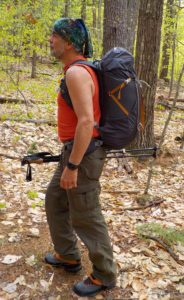
Mike’s well prepared with his modestly sized “summer pack.”
The Objectives of the Kit
Carrying the 13 hiking essentials is first and foremost helping ensure (a) all the necessary items are present. The quality or rating of these items should be based on the typical “worst case scenario” in terms of weather. In other words it’ll be overkill and go unused on most days. When this gear is needed, (b) your survival is key. The quantity of items in the pack should be (c) sufficient for a period of 24 hours even though actually being on the mountain that long is unlikely (but it is possible) — we call this the “24-hour pack concept.” To make this possible the contents of the pack must be able to (d) remain dry and usable since weather in the mountains over that long a period must always be suspect. Some of the contents must be (e) useful in an emergency supporting a proper backcountry medical response. And lastly, a final objective: the pack should (f) not be oversized or overweight. For the sake of balance, if nothing else (though comfort does matter), pack weight needs to be manageable. The good news is is that it can be, while still meeting all of the objectives listed. For Mike’s kit, the weight with full food and water on board, along with his cellphone, is just under twenty-two pounds (9.9 kg). That’s not too bad, is it? Let’s take a closer look.
Contents of the Summer Kit Examined
Please note: the hiker’s 13 essentials are numbered and will appear bold in the text and captions below. Some may note redundancies as qualifying like-essentials are carried with backups. This is intentional and in the interest of safety.
The Pack, Pad, and Waterproofing
For a couple of seasons the pack of choice in the warmer months when carrying a smaller sized pack is possible has been a Gossamer Gear pack called the Lonestar 30 (first as a prototype, then as a production model). As the name implies, it was designed in Texas (“Born in Austin”) and has a thirty-liter capacity. It’s an ideal size and this pack’s other features — such as its brain, inner pocket, shoulder strap pockets, optional hip belt pockets (which may be substituted or removed if wearing a climbing harness), and external hydration pocket make it an ideal choice. It is a climbing pack by design and fairly streamlined (see inset photo, above), but serves very nicely as a hiking pack and seems to just swallow up gear. We love it.
We first insert (1) a foam sleeping pad, cut down in size to accommodate only typical shoulder widths and just enough length to protect the patient from head to butt (beyond that is unnecessary). The pad is coiled loosely and placed inside the pack giving it shape which helps out when adding other items later. Once installed in the pack, a super tough trash compactor bag is added. This will serve as a waterproof liner. It totally works.

Thirty liter pack, cut down (1) foam sleeping pad, and an impervious trash compactor bag serve as a good foundation.
Items Attached to the Pack or Personally Carried
We prefer keeping most items inside the pack when possible, but that’s not always the case. Anyway, some smaller items can be indispensable. Navigational items such as a (2) map and compass are best carried on your person or in a very accessible pocket. These tools are only useful if they are put someplace which encourages and facilitates their use. We also have personal items readily available, (3) sun protection being an important one nowadays. Also handy are a (4) whistle in case you need to get someone’s attention and a (5) small knife… probably just used for lunch.

A (4) whistle, a (5) small knife, magnetic north-indicating (2) compass, and a dog deterrent are all ready to deploy.

The appropriate waterproof (2) map, a Suunto A-30 (2) compass, and sometimes a printed (2) map detail.
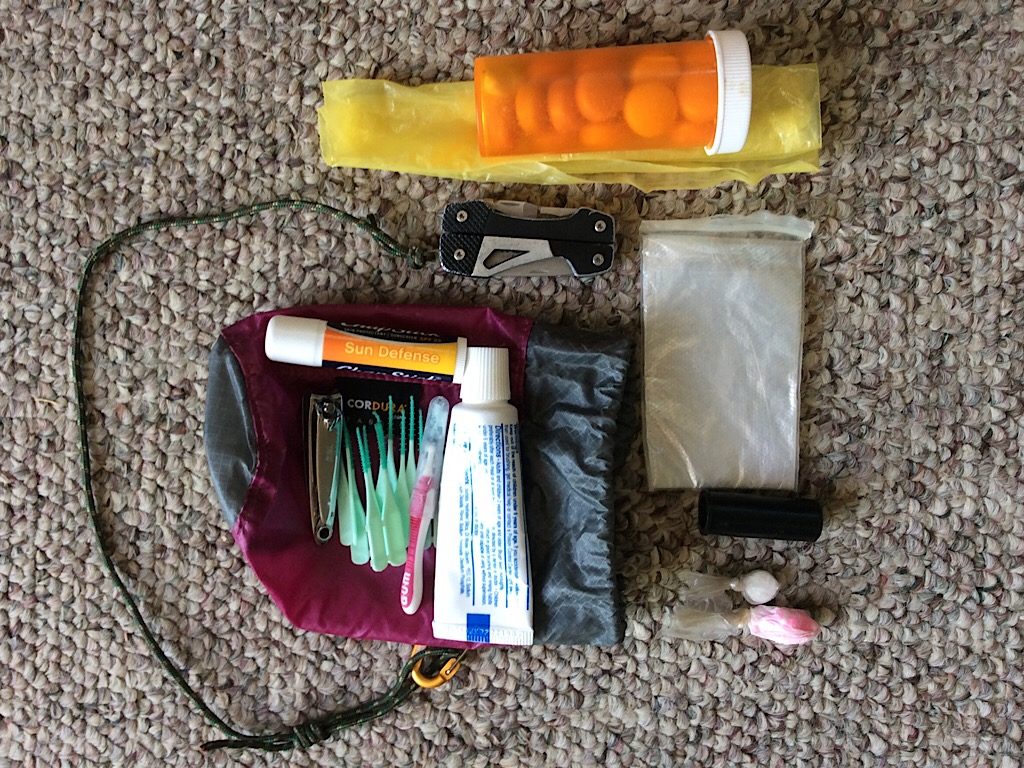
In the hip belt are personal items like chewing gum with refuse bag, (3) sun protection, and hygiene items, helpful stuff life a (5) multitool, and life-saving emergency (6) first aid items like a CPR mask, aspirin, and Benadryl
Gear on [in] the Brain
Many packs feature a brain or lid on top of the pack. It’s a convenient place to secure those small, ever useful “kitchen junk drawer” type items. Some of the essentials are covered here as well such as a small (5) screwdriver and a small (7) flashlight. These are generally attached to the handy key clip also located in the brain. A number of other items also reside here including a bag within a bag where smaller items are kept. This includes a couple of super handy (6) first aid items, toe warmers, (3) Dermatone, a ball cap, a permanent marker, various length and diameters of light (8) cordage, even some (7) spare batteries.
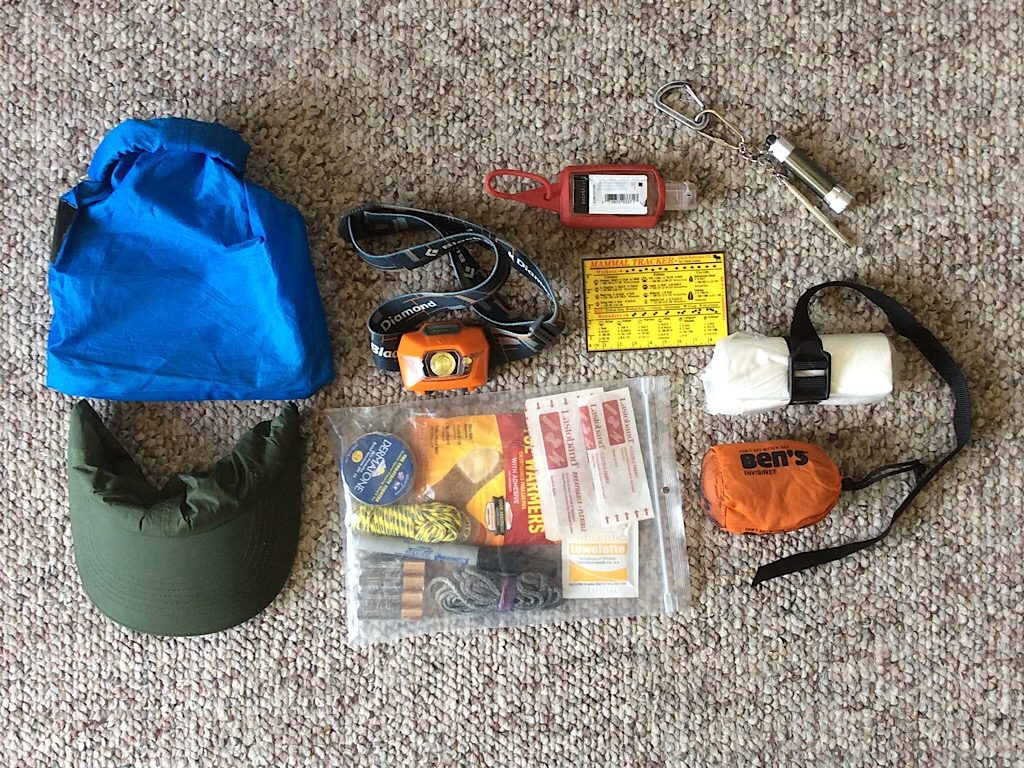
Clockwise from the upper left: notebook with medical info and a pencil, primarily (7) headlamp, hand sanitizer, animal tracking card, (5) screwdriver, (7) flashlight, toilet paper, bug net, miscellany, and a ball cap (makeshift cervical collar).
[Don’t] Stay Thirsty My Friends
Electrolyte tablets are carried with the chewing gum shown above. The minerals and salts are important to help ensure proper hydration and uptake of (9) water. Another thing that also helps is having cold water on a hot day. It encourages one to drink and it feels more satisfying. Since a hydration system can leak or fail, adding a soft bottle full of frozen water to the main bladder serve two purposes: first it acts as an easy-to-melt (if needed) (9) backup; second, it keeps your water cold for hours. Inside the mylar sleeve shown, the water can stay cold all day.
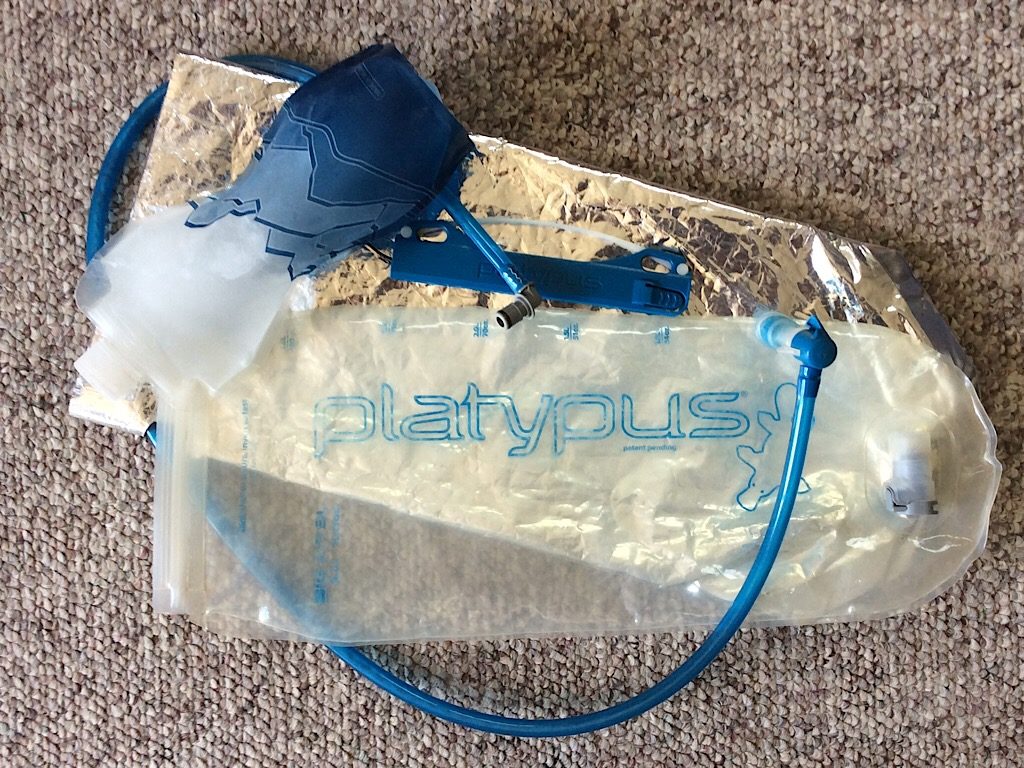
A Platypus hydration system with thermal mylar shell and (9) spare water/ice pack soft bottle.
Starting at the Bottom
The first items to actually go inside the trash compactor bag within the main trunk of the pack will be, by default, the least-likely-to-be-used items. Items really only slated for an involuntary period of time on the mountain or unanticipated overnight stranding. This gear, along with the (1) foam sleeping pad, can spell the difference between comfort or discomfort or, more importantly, the difference between life and death. Items include (10) extra layers like a puffy jacket, (11) shelter like a bivy, rain fly, or tarp, and even some (10) spare socks (with two hospital-grade vomit bags to protect against wet boots — and because grandma’s bread bags always leak).
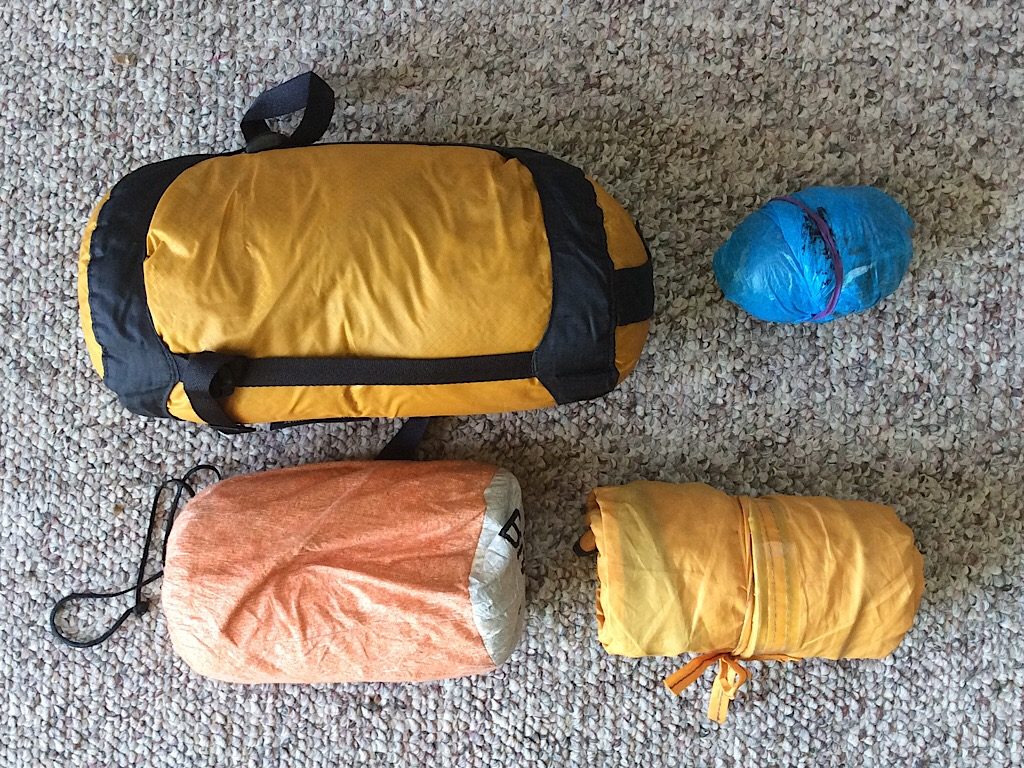
Starting from upper left: (10) parka, (10) spare socks, (11) rain fly, and (11) bivy.
Then Working Our Way Up
Next in the column is Mike’s primary homegrown (6) first aid kit along with a secondary massive trauma kit only used under certain circumstances or when guiding in trauma-likely terrain. Also present on this level is an emergency/repair kit, also containing many of the 13 Essentials. Items include a larger second (5) knife, a large hank of strong larger diameter (8) cord — useful for improvising a litter, hanging a bear bag, and more — a backup (7) headlamp, and a (12) fire-starting kit with several items like cotton balls with petroleum jelly, a ferro rod (used with the large knife), even some fat wood to use as tinder. Also present in this kit are two flameless ration heaters (FRH) used in lieu of a stove to heat military “meals, ready-to-eat” (MREs), and some water purification tablets (a Sawyer Mini filter is sometimes used instead) to accommodate for added (9) water.
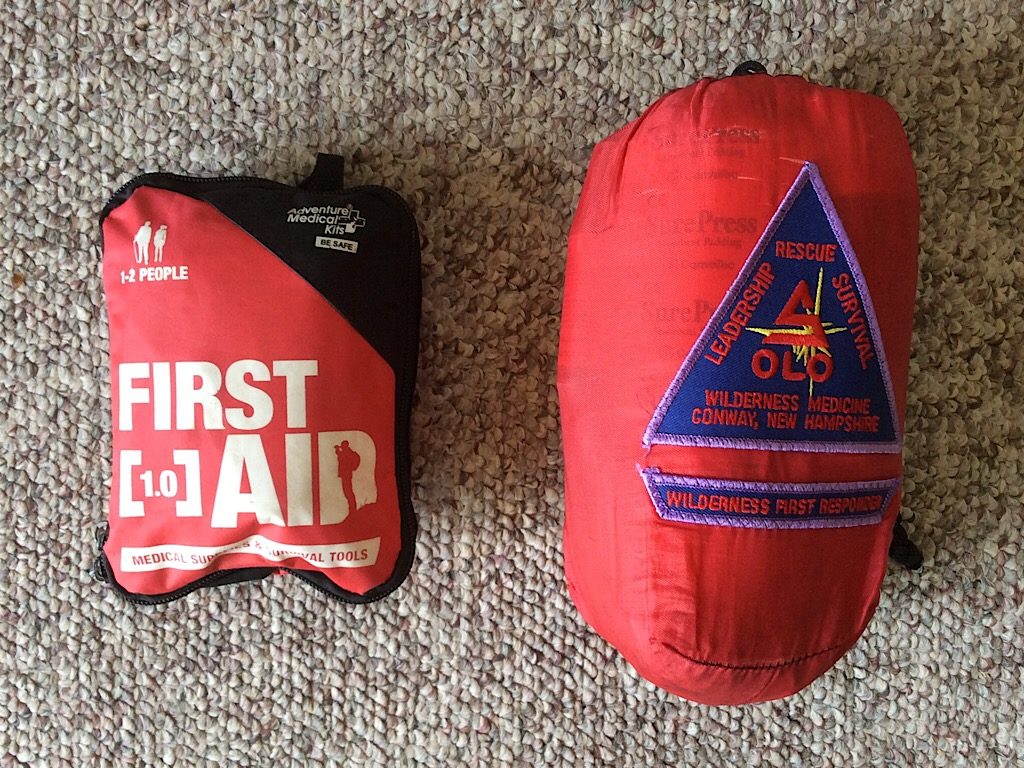
The small (6) first aid kit is always present. The larger one in special cases.
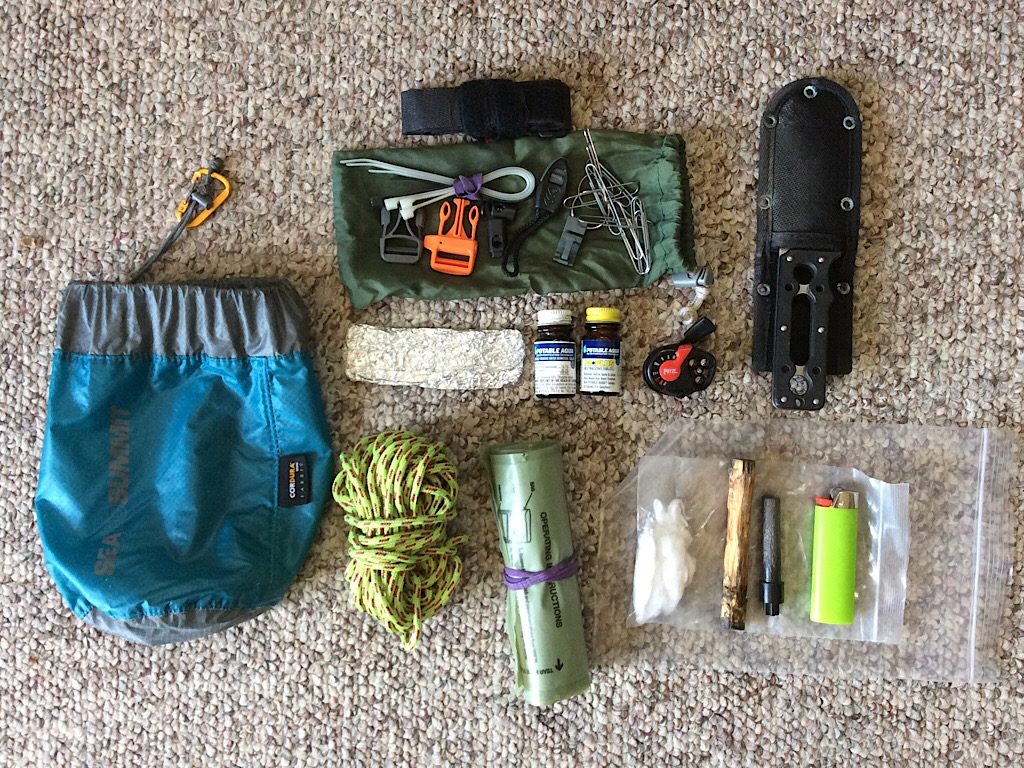
Clockwise from upper left: Bag for kit; repair items (buckles, wire items, clips, zip ties, Velcro straps, pulls, and foil); (9) iodine tablets; spare (7) headlamp; (5) knife; (12) fire starters, ration heaters, and (8) cordage.
Layering Like an Onion
Thermoregulating your body temperature is an important concern while hiking making the carry of (10) extra layers a prerequisite. Depending on the person, this will probably mean a number of upper-body layers and protection for the extremities (even in summer). Lower body layering, for many people, is easier to manage. One of a hiker’s biggest challenges is to manage their sweating. Even with purpose-built clothing capable of wicking away sweat, too much sweat is bad.

Multiple upper-body (10) layers. In the photo a hooded shirt, a hoodie jacket, and a light soft shell. At least two of these will generally be carried and need to be accessible, one sometimes stored under the brain for convenience.

A set of base layers (especially important if heading out with gym shorts instead of convertible pants), plus gloves (wool is a terrific summer choice), and a second Buff or hat all add to the (10) extra layers.
Will Hike For Food
Up there, in the cool, thin air, everything tastes great. That is in part the result of being famished after all the effort put forth getting up there. Moreover, the cooler breezes at higher elevations require more calories be given to staying warm when stopping (yes, even in the summer). Food is your friend and as one of the 13 Essentials, having not just water but also carrying and consuming (9) extra food, is like putting gas in the tank during a long trip. It’s necessary to staying on the move.
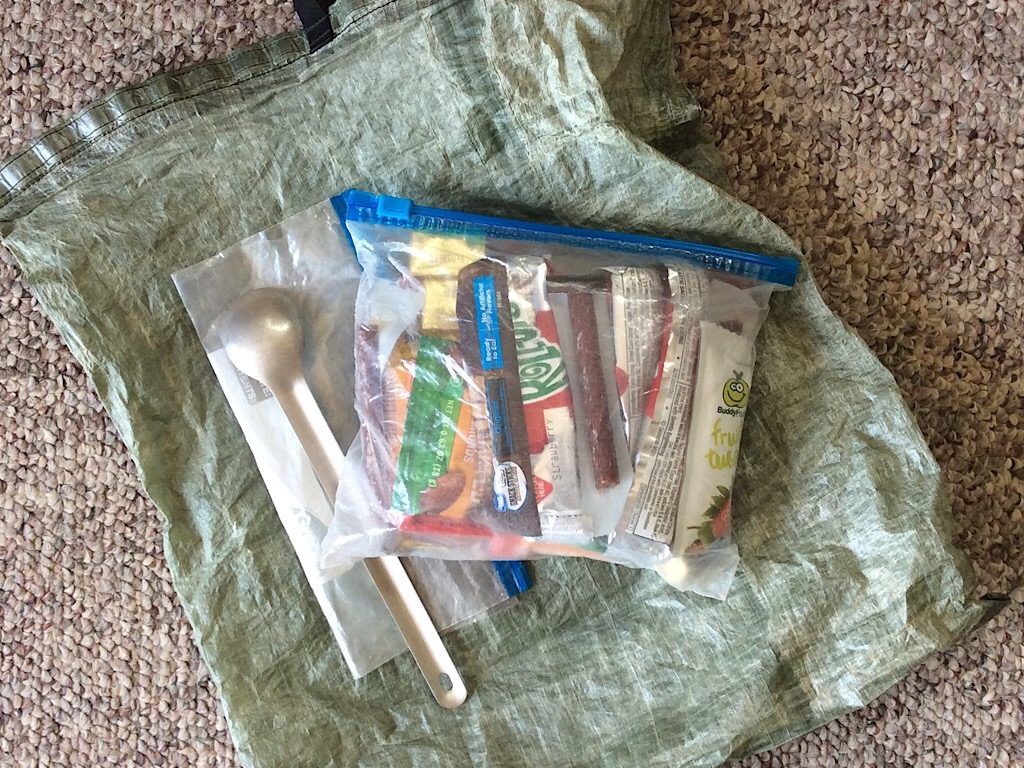
A large assortment of non-perishable (9) foods in addition to actual meals (i.e. sandwich). Shown is a mouse- and waterproof cuben fiber bear bag. It may be hung using the (8) cord carried, above.
Staying Out of the Rain
Under layering, above, we mentioned managing sweat. Sweat cools us through evaporation and conduction. Too much sweat can overwhelm our layers and make us feel cold regardless of fabrics. Another way we can get wet is from rain, clouds, and wet foliage (plus river crossings but that is a whole other subject). To protect ourself from getting wet, (13) wind and rain gear, top and bottom, is essential. This may include a poncho, umbrella, or traditional hardshell pants and jacket. These items should also be “breathable” to help us control sweat when wearing them, but do note breathability of these fabric lacks considerably.
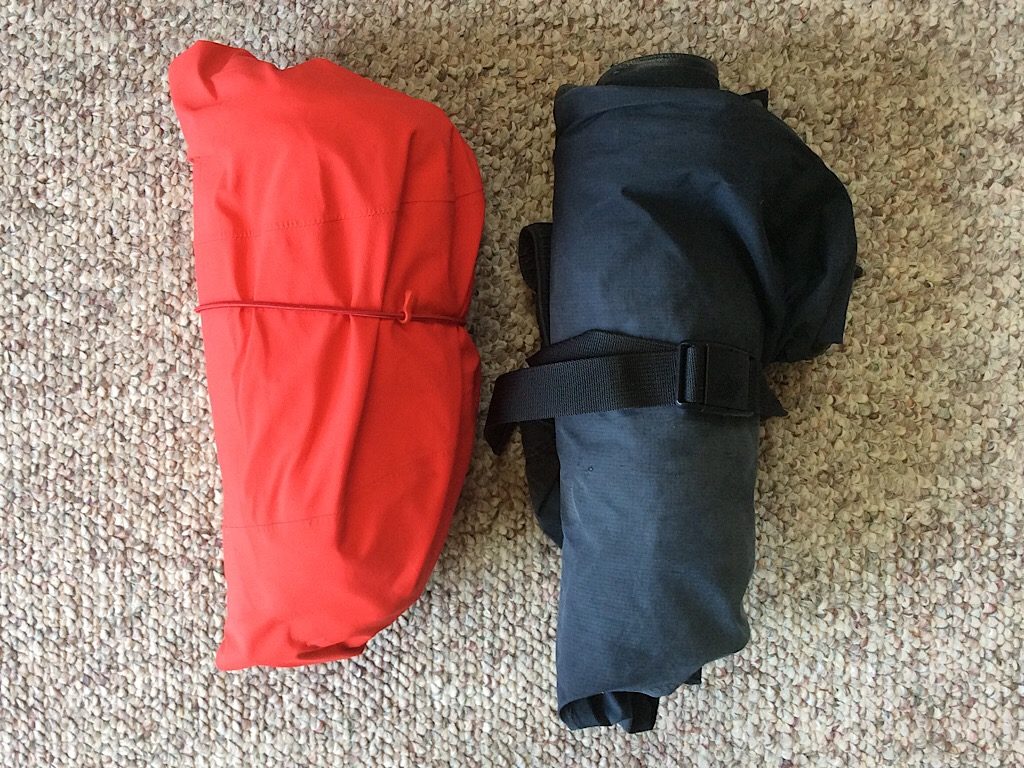
The ever important (13) hardshells for wind/rain protection.
Miscellaneous
Thirteen essential items may look like a lot more once you’re done with all the redundancies (e.g. Mike has about seven items capable of contributing to the (7) creation of light — two headlamps, batteries, cell phone, two flashlights, and the ability of make fire), but yet there is still more we may want to bring. Comfort items like a foam pad to sit on during breaks, in some cases, or really important safety items like trekking poles. Poles aren’t required, per se, but for river crossings, windy days, etc., they can be super helpful. They serve other purposes, too, but that is outside the scope of this particular article. Also of importance is perhaps a dedicated waterproof camera so you can leave your fully charged phone safely in your pack (in airplane mode if hiking in an area without service). Mike goes one step further in that he uses a watch that communicates with his phone. The watch reveals the time, elevation, and so much more. Other dedicated items to consider using instead of your phone might be a “Spot” or “InReach” type device, even an actual GPS with topographical map overlays.
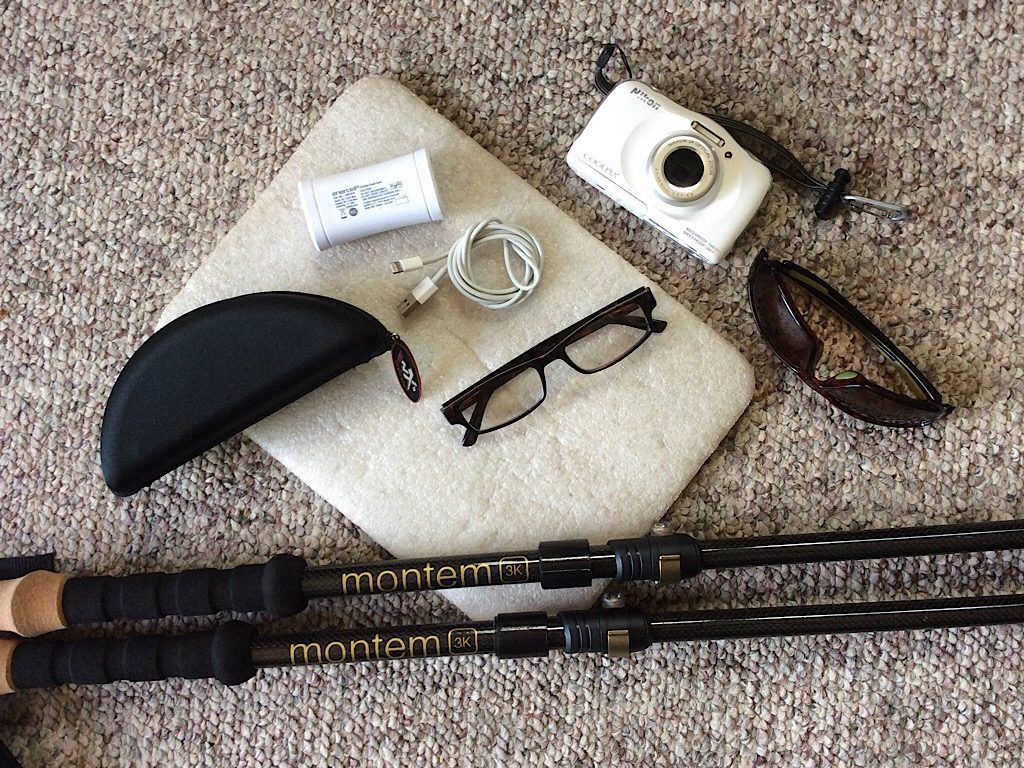
A few more items: butt pad, poles (with 3′ of Gorilla Tape affixed to each for repairs, hot-spot protection, and more), phone charger, reading glasses (important for Mike and he also keeps one pair in his (6) first aid kit), and sun glasses which are really part of (3) sun protection, and a case to carry both glasses in.
For Completeness: The Missing Elements
In case anything seems like it was forgotten, let’s check out these last few items. None are carried, per se, other than on our person. These items include our basic hiking clothing, not the extra layers, and our ever-important footwear.
Clothes for Hiking
These are the layers worn. Everything shown is either wool (the socks) or polypropylene (everything else). These materials are tough and capable of dealing with sweat each in their own way. Not all items shown will be used on the same trip. Convertible pants or gym shorts will typically be worn, carrying both isn’t needed provided the (10) extra layers and (13) rain gear described above (i.e. baselayers, rain pants) are carried as well.
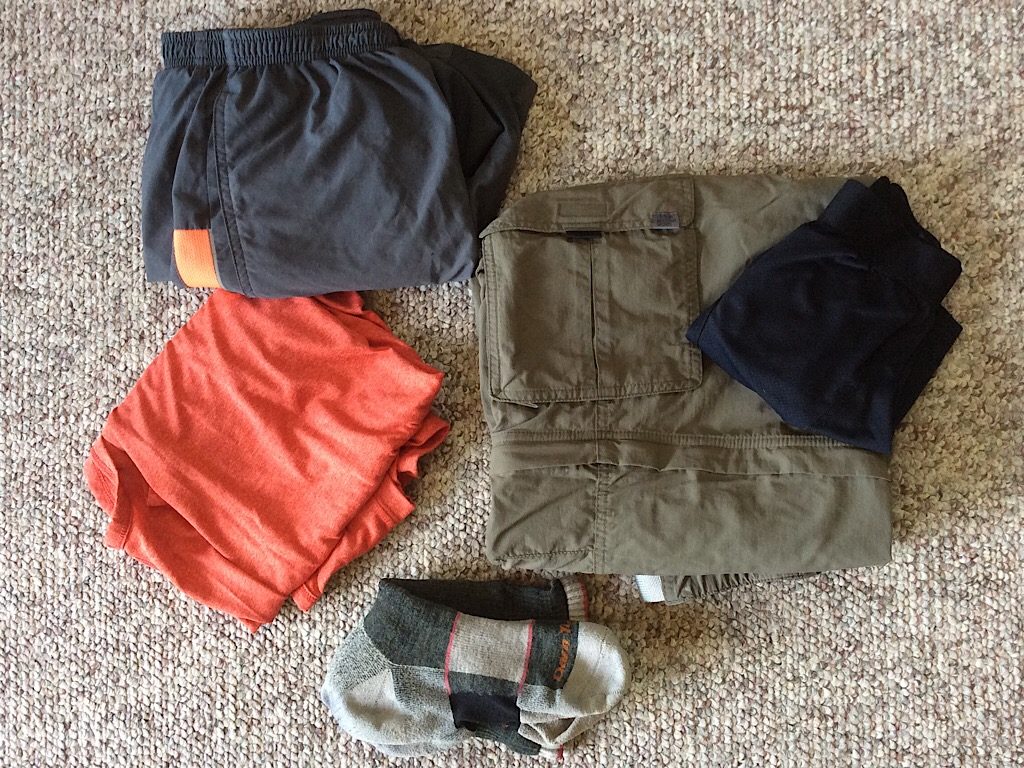
Gym shorts or convertible or zip-off pants with underwear, plus a short-sleeve shirt, and high quality wool socks. Simple.
Proper Footwear
Mike prefers good quality and very grippy “approach boots,” opting for a mid-height design to offer physical ankle protection. The mid-height design might not prevent the rolling of ankles very well, but does offer protection against trauma and abrasions. The boots shown are “waterproof” and feature a Gore-Tex (GTX) lining. Added to this are short summer gaiters to keep debris out of the boots. This is really quite necessary if wearing shorts.

Boots and gaiters.
Gearing Up Only Begins Here…
Winter conditions, mountaineering, rock or ice climbing, backpacking, backcountry skiing, fishing and hunting, and water-related activities all required specialized gear. Crocs, for example, are very helpful for river crossings and during backpacks. This specialized gear is carried in addition to or upgraded from the summer pack contents listed above. It starts here with these essential items. If you’re an outdoors person, don’t leave home without them. The items shown on this page are not overkill, they’re essential when things don’t go as planned. Since we only have limited control over these circumstances, it’s wise to be prepared for the worst. It’s not like it’s unexpected, after all. If you’re even out there a little bit, you should know.
